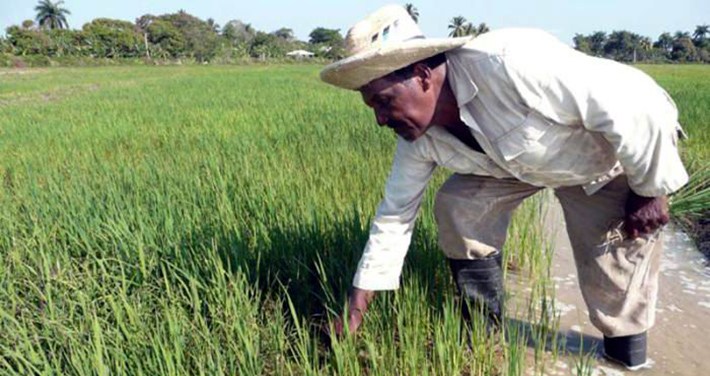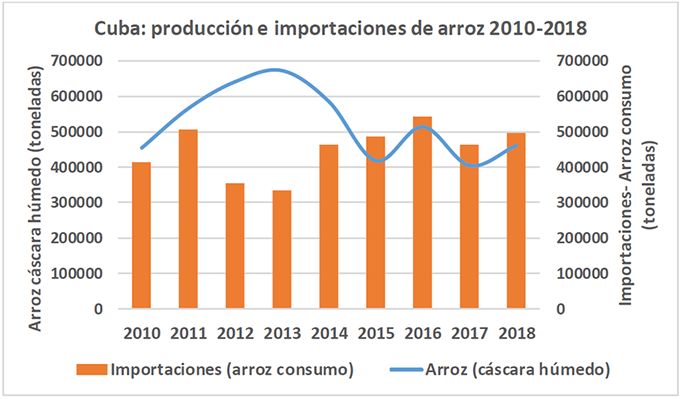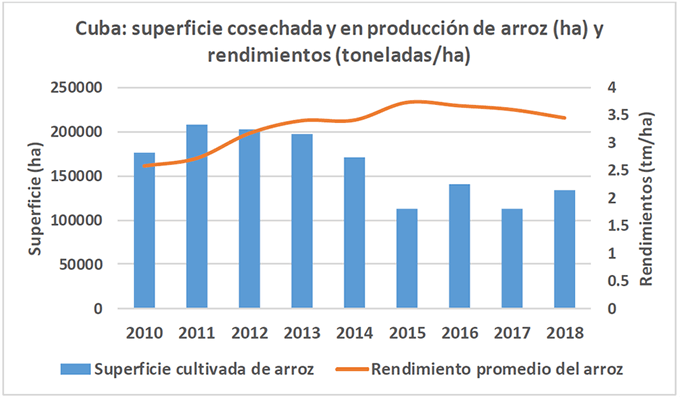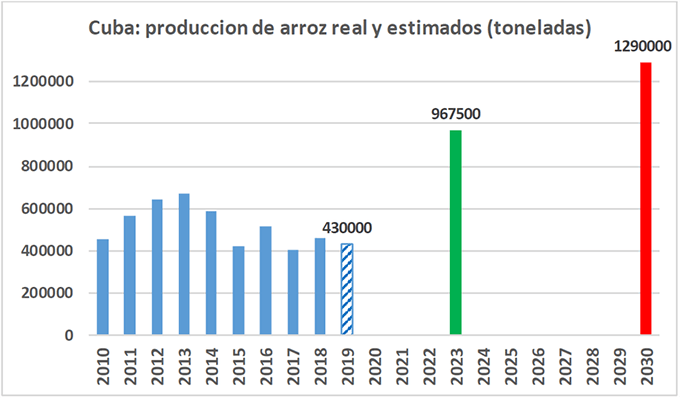Rice Production in Cuba – What do the Stats Say?
By Pedro Monreal (Progreso Semanal)

HAVANA TIMES – At a recent board meeting of governing bodies from every Cuban province, the important subject of rice supply was discussed. (1)
Two issues stood out:
- The discrepancy that exists between the statement that the Rice Program “shows sustained growth in recent years” and the reality that available official statistics show.
- Information about production estimates which are easily refuted.
What was said at the meeting
A news report describes what was discussed in this regard as follows:
“Talking about the evolution and sustainability of the rice program, the head of the sector, Gustavo Rodriguez Rollero, indicated that 14 companies from 13 provinces in the country take part, as well as the special municipality of Isla de la Juventud, and brings together 22,218 producers, 20,472 of whom belong to the cooperative and farming sector.
The Rice Program, closely linked to food for the population and replacing imports, shows steady growth in recent years, even when different infrastructures still need to be repaired and updated.
As a result of this program, some 450,000 tons of rice should be produced by 2023, and it is estimated than 600,000 tons will be produced by 2030, which represents 86% of national demand which currently stands at 700,000.
The Ministry of Agriculture explained that investments have essentially been made in agricultural machinery, implements, the drying and milling industry, and transport. Upgrading works are currently underway at 11 paddy dryers; 9 benefits, classification and seed treatment plants; 17 80-ton scales for weighing; and 14 storage centers for rice hulls with 38 silos.
1,720,700 tons of rice meant for popular consumption has been produced between 2012 and last year, which according to global market prices for rice approved by the Rice Development Project, represents over 849 million USD and means that the country has saved over 242 million USD in the last 7 years.
These statistics go far beyond the undeniable contribution to replacing imports and the country’s economic development as they also have an impact on families’ everyday lives and support much-needed national food production, where the most is made of our potential.”
Before commenting on the subject, it’s worth explaining that figures on national rice production can be expressed with indicators that aren’t the same (although this isn’t normally clarified in official statements made on the subject).
Statistics from reports and annual reports by Cuba’s Office of Statistics and Information (ONEI) uses the “paddy rice” performance indicator, but sometimes (like in the case of the aforementioned meeting) the production figure is expressed as rice ready for consumption, which is a dry product without the hull.
Naturally, a ton of rice ready for consumption (“husked rice”) needs a greater mass of “paddy rice”.
Taking the figure provided at the meeting of 1,720,700 tons of “husked rice” produced between 2012 and 2018, and comparing it with the 3,696,685 tons of “paddy rice” produced between 2012 and 2018 (ONEI statistics), we can calculate a quotient average of 2.15 tons of “paddy rice” for every ton of rice ready for consumption. (2)
“Stubborn” national rice production statistics in Cuba
Contrary to what was said at the meeting, the Rice Program does not “show steady growth in recent years”, something which we can clearly see in the following graph.
The average annual growth rate of national rice production between 2010 and 2018 was 0.18%, that is to say, that in the long-run, there was a standstill in production.
In 2018, rice production was only 1.42% greater than the level recorded in 2010.

During the 2010-2018 period, growth in the first four years resulted in a “peak” in 2013, which then fell and has never fully recovered.
To tell you the truth, production has oscillated in such a way (negatively in more recent times) that it cannot in any way be shown as sustained growth.
In fact, recent news reports indicate that the estimated level of production in 2019 will be less than what it was in 2018, quoting “setbacks in different moments with [shortages of] fertilizers, other chemical products and, more recently, fuel.” (3)
In some regions, such as Sancti Spiritus, there has also been poor water availability for rice production. (4)
It is estimated that 200,000 tons of “husked rice” will be produced in 2019, which would be the equivalent of 430,000 “paddy rice” in 2019. (5)
Imports (which close the wide gap between national production and total consumption) has also oscillated, although towards growth more generally, since 2013.
Recent instability in supplies reflect the way two factors have come together: a tendency towards a “undulating” reduction in the total area of rice cultivation and a tendency of decreasing yields ever since 2015.
With less land for sowing and lower yields, trying to project the image that we have a successful Rice Program is a risky business.

In 2018, the average yield per hectare was 33.7% greater than it was in 2019, but the “area sown and for the production” of rice in 2018 was 24.2% less than it was in 2010.
Natura non facit saltum
Perhaps the most interesting moment in the meeting came when estimates for national rice production in the medium-term (up until 2023) and in the longer-term (2030), were discussed.
It is estimated that 450,000 tons of “husked rice” will be produced in 2023, which would be the equivalent of 967,500 “paddy rice” in 2019. (Green column on the graph). (6)
It is estimated that 600,000 tons of “husked rice” will be produced in 2030, which would be the equivalent of 1,290,000 tons of “paddy rice”. (Red column on the graph).

However, herein lies a problem. As we have mentioned before, the average annual growth rate of national rice production between 2010 and 2018 was 0.18%.
However, the estimate announced at the meeting implies an average annual growth rate of 16% between 2018 and 2023, and an average annual growth rate of 8% between 2018 and 2030.
In the first case (2018-2023), the average annual growth rate would have to be 89 times greater than the real average recorded between 2010 and 2018, and in the second case, the average annual rate would have to be 50 times greater.
The chances that these average annual growth rates are met are very slim, at least if we follow the principle of “Nature makes no leap”.
In summary:
Contrary to what was stated at the meeting, the Rice Program has not “grown sustainably in recent years”:
- In 2018, rice production was only 1.42% greater than the level recorded in 2010.
- The average annual growth rate of national rice production between 2010 and 2018 was 0.18%, that is to say, that in the long-run, there was a standstill in production.
- In 2018, the average yield per hectare was 33.7% greater than it was in 2019, but the “area sown and for the production” of rice in 2018 was 24.2% less than it was in 2010.
Estimates for national rice production in the medium-term (up until 2023) and in the longer-term (2030), seem to have very slim chances of materializing:
- In order to reach estimated production levels for 2023, an average annual growth rate of 16% would have to be recorded between 2018 and 2023, that is to say, 89 times more than the real average growth rate recorded between 2010 and 2018.
- In order to reach estimated production levels for 2030, an average annual growth rate of 9% would have to be recorded between 2018 and 2030, that is to say, 50 times more than the real average growth rate recorded between 2010 and 2018.
Notes:
- Leticia Martinez, Yaima Puig Meneses, “Díaz-Canel: Mantener el ahorro como premisa de trabajo”, Cubadebate, November 27th 2019.
- This calculation assumes that 1,720,700 tons of rice “dedicated to popular consumption” is the result of processing all of the tons of “paddy rice” produced between 2012 and 2018. The fragmented way that these statistics are thrown about at these meetings, makes it hard for us to identify how exact they are with available official statistics.
- Jose Luis Camellon, “Sancti Spíritus: Arroceros cubanos encaran nuevos compromisos productivos”, Escambray, November 16th 2019.
- Jose Luis Camellón, “Limitada la siembra en arrocera Sur del Jíbaro por falta de agua”, Escambray, November 23rd 2019.
- Jose Luis Camellon, “Sancti Spíritus: Arroceros cubanos encaran nuevos compromisos productivos”, Escambray, November 16th 2019.
- Coversion applied to the 2.15 quotient calculated above.
(Taken from El Estado como tal)





